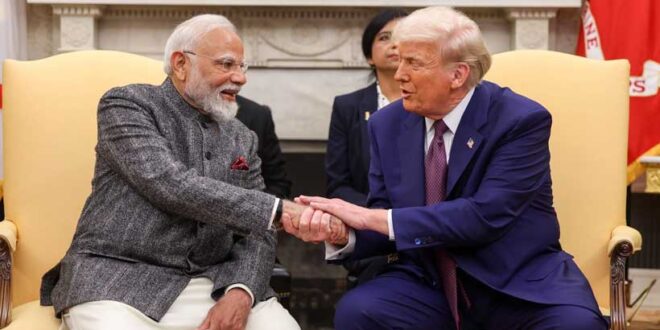In a landmark development poised to redefine geopolitical dynamics in South Asia, U.S. President Donald Trump and Indian Prime Minister Narendra Modi have unveiled an ambitious defence collaboration plan. Central to this initiative is the proposed sale of advanced F-35 stealth fighter jets to India, signalling a significant deepening of military ties between Washington and New Delhi. While this move aims to bolster India’s defence capabilities, it also raises concerns about a potential arms race and regional destabilization, particularly concerning Pakistan.
The announcement followed a high-profile meeting between Trump and Modi in Washington, where discussions spanned trade, immigration, and national security. The defence partnership emerged as a focal point, with both leaders expressing a commitment to enhance military cooperation. This includes a new 10-year framework under the Major Défense Partnership, aiming to strengthen collaboration across air, land, sea, space, and cyberspace domains.
The inclusion of F-35 jets in the defence deal marks a pivotal moment in U.S.-India relations. The F-35, renowned for its stealth capabilities and advanced avionics, would provide India with a significant technological edge. However, the acquisition process is complex and time intensive. Rahul Bedi, an independent defence analyst, notes that while the deal is promising, the F-35s “are not going to come tomorrow,” emphasizing that it will take several years for the aircraft to be operational within the Indian Air Force.
This burgeoning U.S.-India defence alliance is partly driven by mutual concerns over China’s expanding influence in the Indo-Pacific region. By enhancing India’s military capabilities, the U.S. aims to establish a strategic counterbalance to China’s assertiveness. Concurrently, India seeks to diversify its defence procurements, historically dominated by Russian equipment, to include more Western technologies. This diversification is crucial, especially considering the challenges India faces in obtaining parts and upgrades from Russia.
However, this defence collaboration has significant implications for regional stability. Pakistan, India’s neighbour and long-standing rival, perceives the U.S.-India arms deal as a direct threat to its security. Historically, India and Pakistan have engaged in a strategic competition, particularly in the nuclear domain. The introduction of advanced weaponry like the F-35 could exacerbate this rivalry, potentially triggering an arms race. Such a development would not only strain Pakistan’s defence resources but also heighten tensions in a region already fraught with historical conflicts.
In response to the evolving security landscape, Pakistan has been adjusting its nuclear strategy. Recent reports suggest that Pakistan is developing ballistic missile technology with extended ranges, potentially as a countermeasure to India’s enhanced capabilities. While Pakistani officials deny intentions to target the U.S., the country’s strategic recalibration reflects its concerns over the shifting balance of power in South Asia, influenced by the closer U.S.-India defence ties.
The potential for an arms race in South Asia carries profound risks. Both India and Pakistan are nuclear-armed nations with a history of military confrontations. The introduction of sophisticated weapon systems could lower the threshold for conflict escalation, increasing the possibility of miscalculations. Moreover, the financial burden of an arms race could divert resources from essential socio-economic development in both countries, impacting their long-term stability and prosperity.
To mitigate these risks, it is imperative for regional stakeholders to engage in dialogue and confidence-building measures. Transparency in defence acquisitions and strategic intentions can help reduce misunderstandings. Additionally, international frameworks and diplomatic interventions may play a role in fostering stability, ensuring that defence enhancements do not translate into aggressive posturing.
Ultimately, while the U.S.-India defence partnership, highlighted by the proposed F-35 deal, aims to strengthen bilateral ties and address shared security concerns, it also presents challenges to regional stability. Balancing national defence imperatives with the need for peace and stability in South Asia requires careful navigation, inclusive dialogue, and a commitment to preventing an escalatory arms race.
 Geostrategic Media Political Commentary, Analysis, Security, Defense
Geostrategic Media Political Commentary, Analysis, Security, Defense





